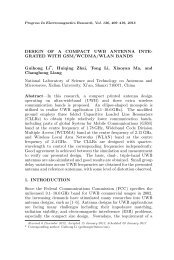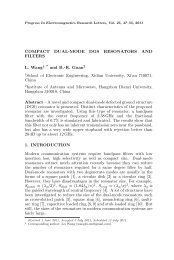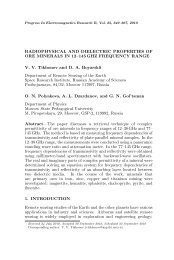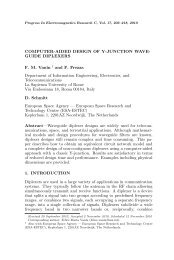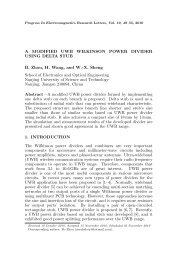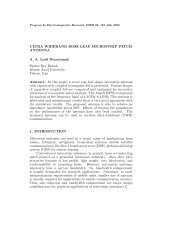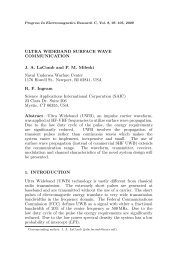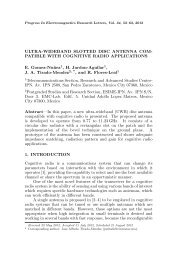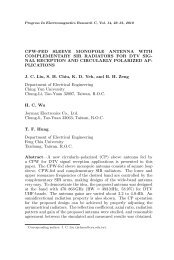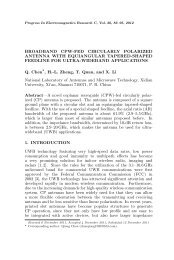UWB-MIMO ANTENNA WITH NOVEL STUB STRUCTURE A ... - PIER
UWB-MIMO ANTENNA WITH NOVEL STUB STRUCTURE A ... - PIER
UWB-MIMO ANTENNA WITH NOVEL STUB STRUCTURE A ... - PIER
Create successful ePaper yourself
Turn your PDF publications into a flip-book with our unique Google optimized e-Paper software.
Progress In Electromagnetics Research C, Vol. 19, 2011 253<br />
systems require low variation in gain values over the operating range<br />
of the antenna. From Fig. 8(a), it can be noticed that the variation<br />
in the gain values is found to be less than 2.5 dBi that is quite good.<br />
Further, the variation in efficiencies as shown in Fig. 8(b) throughout<br />
the bandwidth is also not more than 15%.<br />
4.2. Time Domain Performance<br />
The radiating elements of the designed <strong>UWB</strong>-<strong>MIMO</strong> antenna are<br />
also characterized for its time domain performance to confirm their<br />
capability for <strong>UWB</strong> operations. The radiating elements are fed by<br />
the fifth derivative of Gaussian pulse of 0.13 ns wide where the pulse<br />
width is measured at 50% of the maximum amplitude. The selection<br />
of this excitation pulse can be justified by its spectrum that efficiently<br />
meets the requirements of FCC approved <strong>UWB</strong> spectral mask [15].<br />
The time domain impulse response of the left element of antenna with<br />
and without the stub in the far-field zone is shown in Fig. 9(a). It can<br />
be seen from the figure that the pulse of width of 0.185 ns is radiated<br />
from antenna. Thus, it indicates good time domain response and it can<br />
be further justified by group delay shown in Fig. 9(b). The variation of<br />
group delay is found to be less than 1 ns showing good phase linearity<br />
and thus it fulfils the requirement for <strong>UWB</strong> operations.<br />
4.3. <strong>MIMO</strong> Characteristics<br />
It is evident that <strong>MIMO</strong> antennas are required to be characterized<br />
for their diversity performance. In a diversity system, it is usual<br />
that signals can be correlated to some extent, hence measuring the<br />
degree of correlation between two antenna elements becomes important<br />
(a) (b)<br />
Figure 9. Time domain characteristics.





